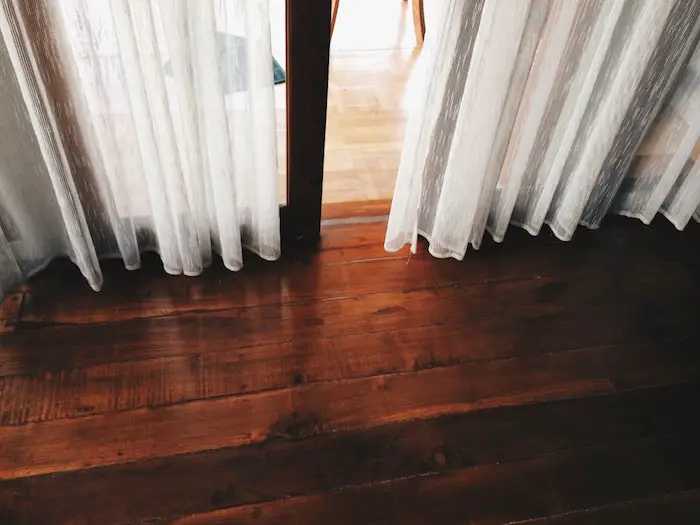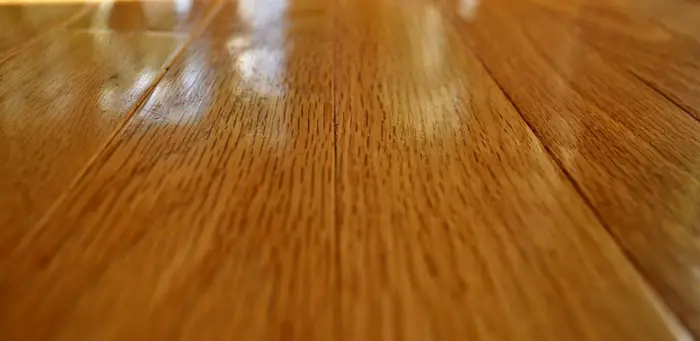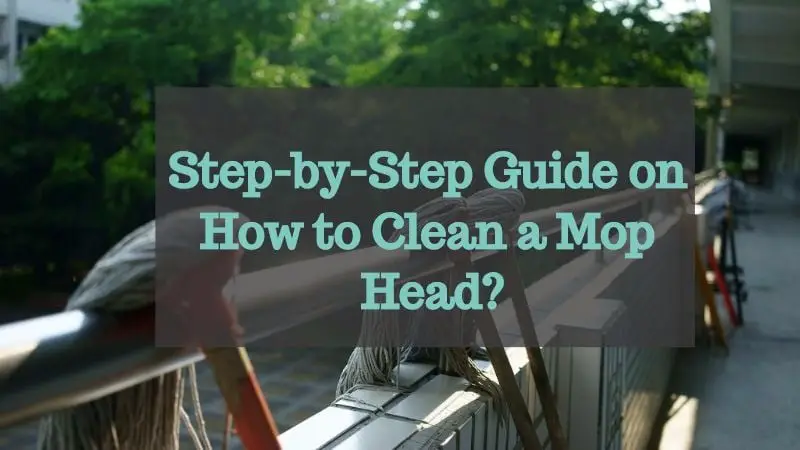Sweeping your hardwood floors sometimes isn’t just enough to get a clean, sparkling and polished floor. So, what’s the best and safest way of cleaning your hardwood floor? Well, this guide is here to help you learn how to use bleach water on your hardwood floors the right way without damaging your floors.
Can you mop hardwood floors with bleach water? Yes, but only when used properly and the solution mixed at the right ratio. A small amount of bleach properly diluted with water is a great and safe solution for cleaning your hardwood floors. But of course, it all depends on how you use it.
Using the wrong cleaning products to mop your hardwood floors (see my mop reviews) may cause more damage than good to them. But all you need to do is understand the right and safe technique to mop your hardwood floors. With bleach water, you can easily remove all the grime, the mildew, the stains and dirt on your hardwood floor. Read on to find out how…
How to Mop Hardwood Floor with Bleach Water
Mopping your hardwood floors with diluted bleach comes with a number of benefits. With bleach water, you get to disinfect your floors and keep them clean at the same time. Stubborn stains and grime on your floor can easily be removed with the right type of solution.
Bleach water can help you restore the original color and finish of your hardwood floors without causing any damage to your floor. Mopping your floors with bleach water is safe, but how you do it matters a great deal. If you choose this method to clean your hardwood floors, then you have to carefully follow these 7 easy steps:
What you’ll need
- Dry Microfiber cloth or mop (see my previous reviews)
- Bleach
- Bucket
- 1 gallon of water
- Broom
- A pair of gloves
Step 1: Sweep your floor with a completely dry mop or broom. This will help to remove the debris off the surface and other large particles of dirt like sand that may scratch your floor during the mopping process. Sweeping your hardwood floors is an important step to get rid of any scratchy materials and dust from your floor.
Step 2: Take 1 gallon of water, proceed and add a ½ cup of bleach. Put on a pair of gloves. Thoroughly mix the solution in a bucket until the bleach is completely diluted. The aim is to clean your floors without causing any damage to them, so the bleach needs to be minimal depending on the type of hardwood floor you have.
It is important to make sure that the bleach has properly diluted before any further step. After mixing your solution, you will now have your bleach water ready.

Step 3: Dampen your microfiber cloth or mop and wring it thoroughly to make it almost dry. Your mop should not be dripping with bleach water or sopping wet. It should be lightly damp and almost dry. You may choose to spray your microfiber cloth or mop with the bleach water, in this case, you’ll need to fill a spray water bottle with bleach water first.
Wring out your mop or cloth as well as you can until it’s slightly damp. It’s important to ensure your mop or cloth is not dripping any bleach water, this will ensure you don’t end up flooding your floors. Harwood floors should not be exposed to a lot of moisture, so having a well wrung out mop or cloth is vital.
Step 4: Do a test by wiping your mop or cloth at the corner of your floor or small section which can barely be noticed. This test will help you know if the solution might affect your hardwood floors. Start mopping in smaller sections to remove dirt and stain on your hardwood floor.
Where there is stain or mildew, try using your mop or cloth to rub off that section. After completing all the sections of your hardwood floor, leave for 10 minutes for bleach water to remove all the stain, mildew and grime stuck on your hardwood floors.
Step 5: Thoroughly rinse your microfiber cloth or mop in water to remove the water bleach. Thoroughly wring your mop or cloth until it’s almost dry. You can choose to use another different microfiber cloth or mop for this step.
Step 6: Use your almost dry mop or cloth to clean up any moisture on your hardwood floor and water bleach. Wipe your floor thoroughly until there is no moisture or water bleach left on your floor.
Step 7: Air drying your hardwood floors. Make sure the place is well ventilated by opening all the windows and doors. Keep off your pets or anyone from the hardwood floor until it’s completely dry.
Dos and Don’ts of Cleaning your Hardwood Floors
What to do;
- Do put on a pair of protective gloves to ensure your skin is safe especially if you are allergic to bleach.
- Do use the correct solution ratio for your hardwood floors. The bleach should not be in excess amount. Neversplatter water or flood your hardwood floors with water. Avoid saturating your hardwood floors with water. This helps to minimize the moisture on your hardwood floors. Moisture may seep through the boards and make them swell and expand on the edges.
- Do follow the cleaning method recommended by your floor manufacturer first.
What not to do;
- Do not use undiluted bleach on your hardwood floors. Dilute your bleach first to ensure it doesn’t cause any damage to your hardwood floors.
- Do not use a sopping wet or dripping mop on your hardwood floor. Your mop or cloth should be almost dry or slightly damp. This measure is important to prevent any moisture or water from seeping through and buckling or staining your floors. Moisture may enter the boards.
- Do not use a hard broom for sweeping. The rigid bristles may scratch your hardwood floor. Always go for a broom with soft bristles.
Tips for Cleaning your Hardwood Floors
- Determine the type of finish you have on your hardwood floors before you proceed to remove any stain. Unsealed hardwood floors absorb water easily than finished hardwood floors. Consult your manufacturer to know the right way of cleaning your hardwood floor depending on the type of finish you have.
- Use distilled water to avoid any streaking or residue buildup after cleaning your hardwood floors.
- Minimize sand, heeled shoes and grit it may cause damage to your hardwood floors.
- You may use a spray water bottle to spray the bleach water on your mop or cloth for easy cleaning. But don’t spray directly on your floor, only spray on your mop or cloth.
- If you choose to use a vacuum to rid of the dust (see reviews), remember to check under your vacuum to ensure it doesn’t have any metal elements that may scratch the surface of your hardwood floors.
- Sweep your floors using a broom, to get rid of sand or debris that may end up scratching floors during the mopping process.
- Keep the place well ventilated after mopping to ensure your hardwood floors completely dry. Keep your fans running and the windows open for proper drying.
- Remember to leave your hardwood floor to air-dry at least for 24 hours while keeping off any pets from the floor.
- Use a mat or carpet on your floors especially in high traffic places when you are expecting visitors. This will help protect your hardwood floors from high-heeled shoes.
- Always remember to take your shoes off and trim your pet’s nails (see how to protect hardwood floors from dogs).
- Remove any dust or dirt by sweeping before mopping.
Related Questions
Q: How can I clean my hardwood floor without streaking or leaving any residue on the floors?
A: Use distilled water while mopping your hardwood floors and rinse your mop before wiping your floors the last time. Buffing and rinsing your floor also helps to prevent streaking. While rinsing your floor use an almost dry mop that has been well wrung out and does not have any bleach water.
Q: Can bleach damage hardwood floors?
A: Yes, if not used properly and diluted. Undiluted bleach is not recommended on your hardwood floors, its’ full strength is harsh on your floors. You must always dilute bleach before applying it on your hardwood floors. That’s why it’s advisable to use bleach water to deep clean your hardwood floors.
The solution must be mixed at the right ratio to get excellent and safe results. Depending on your finish, always do a test on a small section like for example at the corner of your floor to be sure the solution is right for your floor.
Q: How often should I use bleach water on my hardwood floors?
A: Bleach water is the best solution when it comes to deep cleaning. You can use bleach water twice per month during your deep cleaning session. But when you want to remove stain or mildew, oil stuck on your floor then you may use bleach water, it doesn’t have to wait until your deep cleaning session.
Conclusion
Bleach water is the best cleaning product when you want to get some deep cleaning done on your hardwood floors. But if not used properly bleach can also cause damage your hardwood floors. To avoid any damage on our floors carefully read and follow the 7 steps above.
Get your solution right. If you use the right dilution and follow the above steps carefully your floors will be safe. Say goodbye to discolored hardwood floors by following our guide for mopping hardwood floor with bleach water!


